Runcorn, Cheshire
Up to 1834
A workhouse existed at Grappenhall from around 1745 (Hitchcock, 1985).
After 1834
The Runcorn Poor Law Union formally came into being on 26th August 1836. Its operation was overseen by an elected Board of Guardians, 42 in number, representing its 40 constituent parishes as listed below (figures in brackets indicate numbers of Guardians if more than one):
County of Chester
Parish of Runcorn: Acton Grange, Aston Grange, Aston-by-Sutton, Clifton-by-Rocksavage, Daresbury, Halton, Hatton, Keckwick, Moore, Newton by Daresbury, Norton, Preston-on-the-Hill, Runcorn (3), Stockham, Sutton, Thelwall, Whitley Superior, Whitley Inferior, Weston.
Parish of Great Budworth: Antrobus, Bartington, Great Budworth, Crowley, Dutton, Hull and Appleton, Sevenoaks, Stretton, Walton Superior, Walton Inferior.
Parish of Grappenhall: Grappenhall, Latchford.
Parish of Frodsham: Alvanley, Frodsham Township, Frodsham Lordship, Helsby, Kingsley, Manley, Newton-by-Frodsham, Norley.
Parish of Delamere: Kingswood.
The population falling within the Union at the 1831 census had been 22,858 — with parishes ranging in size from Aston Grange and Clifton-by-Rocksavage (population 75 each) to Runcorn itself (5,035). The average annual poor-rate expenditure for the period 1834-36 had been £6,880 or 6s.0d. per head of the population.
In 1839, Runcorn was one of the small group of unions who were listed by the Poor Law Commissioners "which for the present decline to concur in providing an adequate Workhouse". Under the threat of the union being dissolved, the guardians were eventually persuaded to fall in line and in 1855-7, a union workhouse for 200 inmates was built at the east of the village of Dutton, around four miles to the south-east of Runcorn. It was based upon a broadly cruciform plan, which was unusual for a workhouse of that date. It was a plain structure of red brick with an Elizabethan-style frontage, surmounted by a turret with a clock. The workhouse infirmary was enlarged in 1881-2. Other extensions took place in 1895, and a nurses' home was added in 1906. The workhouse location and layout can be seen on the 1911 map below.
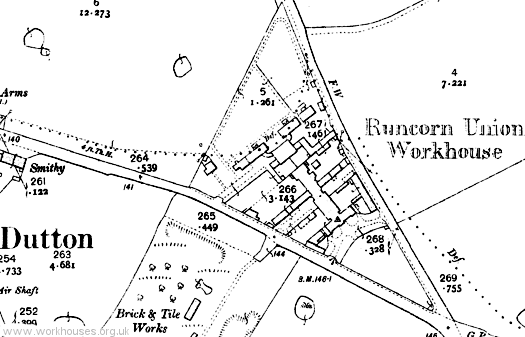
Runcorn workhouse site, 1911.
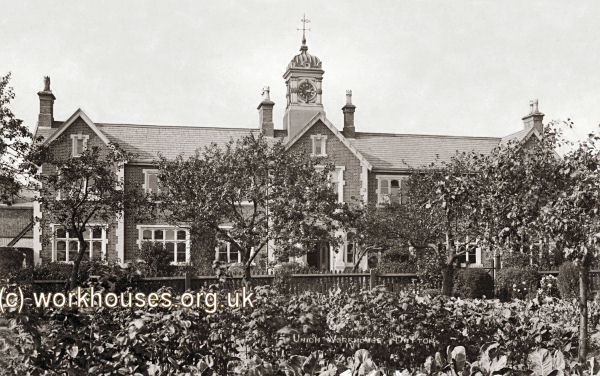
Runcorn Union workhouse from the south-east, Dutton, early 1900s.
© Peter Higginbotham.
After 1930, the establishment became a Public Assistance Institution under the management of Cheshire County Council. It joined the National Health Service in 1948 as Dutton Hospital, providing treatment for the chronic sick with 74 beds. The hospital was closed in about 1966.
In 1940, Charles and Evelyn Woad became master and matron of the establishment. Their son Geoffrey has very kindly provided some pictures which he took with his "box Brownie" camera during their time there.
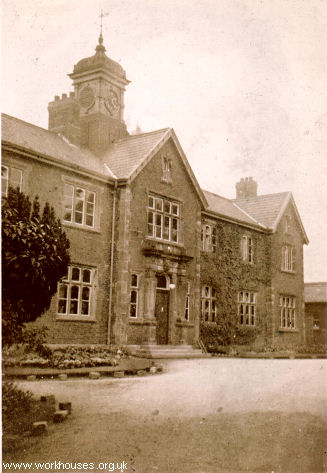
Front of the building in September 1948.
© Geoffrey Woad.
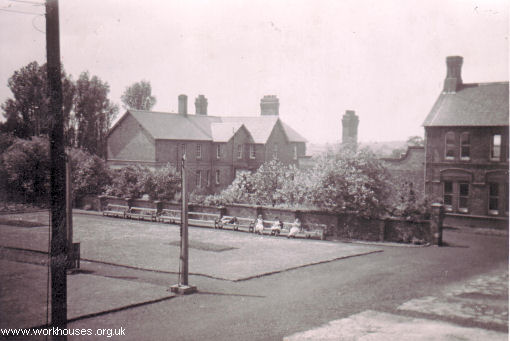
View from sitting room window, to the nurses' home, operating theatre, and female wards.
© Geoffrey Woad.
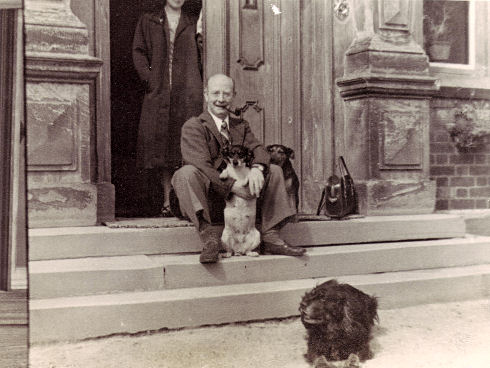
Charles Alfred Woad, master, on the front step.
© Geoffrey Woad.
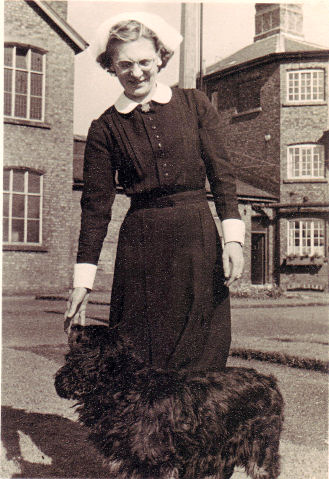
Mrs E. Woad, Matron. Left is the Chapel and dining room, behind her is main kitchen, at right is the main building. Our dining room was the bottom room, above it our sitting room. Above that was the porters bedroom.
© Geoffrey Woad.
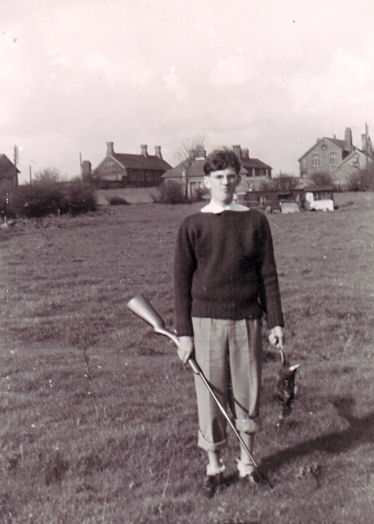
Geoffrey Woad on the "Brickie", with the hospital in the background. All the bricks for the hospital were made in the brickyard on the opposite side of London Road.
© Geoffrey Woad.
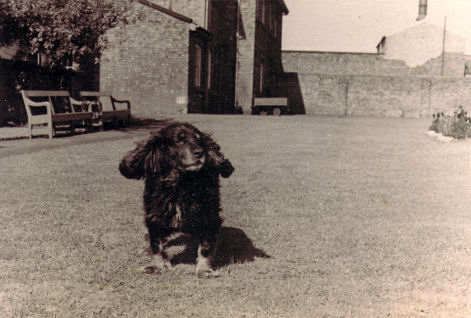
The family dog "Zero" - in the background is the central area of the hospital between the chapel and the rear block.
© Geoffrey Woad.
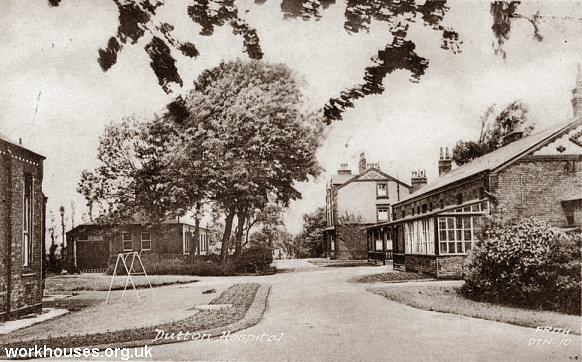
Buildings at the rear of the site.
© Peter Higginbotham.
All the workhouse/hospital buildings have been demolished and housing now occupies the site.
Children's Home
In 1913, the union established a home for around sixty children at Dutton Lodge, a large, old, gentleman's residence on Lodge Lane, Dutton. The boys occupied the west wing, with the former drawing-room serving as their dayroom. The girls occupied the central portion and the east wing, their dayroom being the former dining-room. The room next to this was used as a joint dining-room and had a large opening into the adjoining kitchen. Dormitories were located at the respective sides of the first floor. The buildings at the north side of the road, previously utilised as stables, were converted into a manual instruction room and laundry. In the latter, the girls were taught washing and ironing, and modern appliances were installed for the purpose. They were also instructed in dressmaking, cookery and housewifery. The boys learned the elemnts of carpentry, joinery, gardening and shoemaking.
Staff
Inmates
Records
Note: many repositories impose a closure period of up to 100 years for records identifying individuals. Before travelling a long distance, always check that the records you want to consult will be available.
- Cheshire Archives and Local Studies, Cheshire Record Office, Duke Street, Chester, Cheshire CH1 1RL. Holdings comprise: Registers of births (1858-1943), Registers of deaths (1866-1960), Creed registers (1914-1951), Registers of inmates (1907-1960).
- Some workhouse records are now accessible online to subscribers of Findmypast.
Bibliography
- Hitchcock, T.V. (1985) The English workhouse: a study in institutional poor relief in selected counties. l695-l750. (DPhil thesis. University of Oxford.)
Links
- None.
Acknowledgment
- Much appreciation to Geoffrey Woad for contributing the wonderful pictures.
Unless otherwise indicated, this page () is copyright Peter Higginbotham. Contents may not be reproduced without permission.


